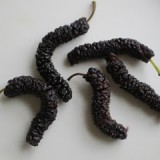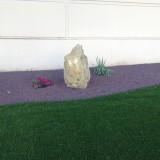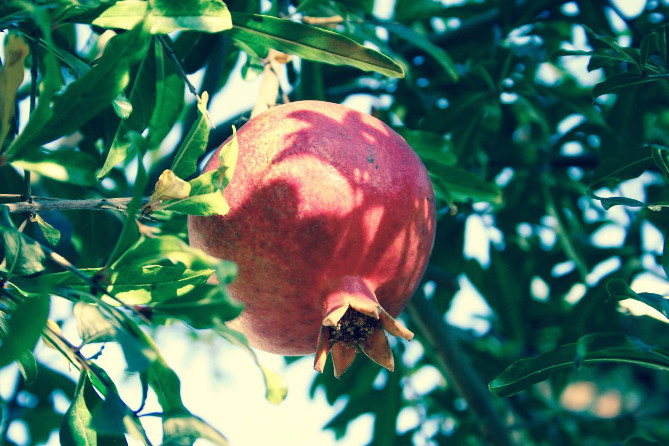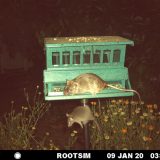In the fall of 2009 a citrus pest called the Asian Citrus Psylid showed up in our neighborhood. It’s a major concern to commercial citrus growers since the pest spreads an incurable and fatal plant disease called huanglongbing (HLB).
The California Department of Food and Agriculture commenced a futile effort to suppress the psylid by hiring a contractor, TruGreen, to spray residential backyards in Southern California with a combination of imidacloprid (deadly to pollinating insects) and pyrethroid.
As I expected, it didn’t work. The state’s strategy has now shifted to releasing a parasitic wasp (Tamarixia radiata) imported from Pakistan. Citrus farmers will continue heavy applications of pesticides to keep the psylid at bay. UC Cooperative Extension biological control specialist Mark Hoddle explained to KQED (italics mine),
Hoddle says Tamarixia radiata won’t eradicate Asian citrus psyllid. Commercial citrus producers in California will still continue to apply insecticides to prevent the spread of Huanglongbing. But, he says, state regulators have already determined backyard pesticide applications are too expensive ($10-11 million so far) and too ineffective to bother with.
Frankly, I’m inclined to conclude that the original eradication program was a make-work program for CDFA officials and TruGreen all made possible by a big infusion of cash from our tax dollars and the citrus industry.
During their backyard spraying campaign in our neighborhood in the fall of 2010, the CDFA and TruGreen showed up at a neighbor’s house who, at the time, had over 50 citrus trees in pots (she was operating a mini-nursery and selling the trees). CDFA and TruGreen were overwhelmed by the amount of trees and ran out of imidacloprid. They promised to return but never did, leading me to believe that they weren’t really interested in eradicating a pest but were, instead, engaged in a kind of “pesticide theater”. It’s a bit like the security theater that goes on everyday at our nation’s airports courtesy of the TSA.
Even with the parasitic wasps I’m not planning on planting any citrus or recommending that citrus be planted in Southern California backyards. Everywhere in the world the psylid has shown up, HLB has followed within a decade. I strongly suspect that growing citrus in SoCal will be like trying to grow table or wine grapes here. With grapes, Pierce’s disease, spread by a very similar insect called the glassy winged sharpshooter, makes it impossible to grow anything but resistant varieties unless you use a lot of pesticides. Until a HLB resistant citrus tree shows up (probably by means of genetic modification, never a great option IMHO) I’d stick to pomegranates and figs.







Has this citrus pest eradicated citrus harvests in other areas? An “incurable and fatal plant disease” would destroy the citrus crop in CA and move to other parts of the country?
Following the lead of Arden Anderson (books available through Acres USA), pests are attracted to stressed plants. What’s stressing the citrus in your area, and the ash trees here in the Midwest (ash borer)? Unless we answer that question, all spraying is just theater.
Kirk, There are numerous stresses on citrus here. First off, too much of it both in backyards and planted commercially. In backyards it is also often overwatered and pruned badly. Yet another stress–the port of Los Angeles. If you look at the pattern of the ACP it follows the trucking route out of the port. We need to keep things local and stop importing crap from China!
Practical–so far HLB has not showed up in California but it has devastated citrus in Florida.
I really have a problem with the CDFA spraying pesticides on us to save some industry. Is the health of the people less important than an industry’s profits?
The fact of the matter is that we have so little biodiversity in our food crops that it was just a matter of time for this to happen. With most citrus having the exact same genetic material through propagation (all navel oranges are cuttings taken from the original for example) it’s nearly impossible to find resistant plants.
Damn, I no sooner get my citrus trees big enough to withstand the onslaught of Leaf Miners, another “import” fronm Mexico, and now I have to worry about Citrus Psylids. Grrrr.
I’d never heard of this pest until now. What is the state of citrus where this insect comes from – has the native stock developed any resistance? Or does this pest feed on another crop in its native home and only when it arrived here did it find that citrus was a fabulous new food source?
UCDavis has succesfully cross-bred pierce’s disease resistant muscadine grapes with some wine grapes and diluted the strain to have almost no sign of being part muscadine while retaining the immunity, so hopefully we’ll see those on the market soon.
I’ve got a young grape vine that caught pierce’s last year. I drilled a small hole down to it’s cambium (and probably got it’s secondary xylem too) and filled the hole with poultry anti-bacteria (tetracyclene), i wrapped the hole with nursery tape instead of plugging it. It appears to have worked but I’ll see for certain once the growth period has returned.
If my citrus gets HLB then I’ll probably do the same thing. but hopefully we’ll be able to see some disease resistant cross breeds with direct gene manipulation.
we can also grow, persimmons, macadamias, and medlars with great success in our climate, as well as a bunch of others. no need to just stick to figs and poms.
We live in the desert southwest and I know the agriculture dept in AZ is on the lookout for the pests that bring this awful citrus disease.
I have 5 citrus trees in my yard (not sprayed) and hope this won’t be a problem. But my husband and I have discussed what we would replace the plants with. We already have a fig and two pomegranate trees and pineapple guava. Loquats apparently do quite well here but we had a problem with rodents gnawing our poor little trees to death. I’d love to read more about your thoughts about alternatives to citrus.
i meant to say withOUT direct gene manipulation. But, by crossbreeding. oops!
So I’m doomed here in Riverside? Besides having to live with the pollution caused by Port of LA traffic, I can’t have citrus trees now?
The city of Redlands has recently sent out notices to grove owners and residents with front or backyard citrus trees that pyrethroid and imidacloprid insecticides will be applied to foliage and ground. In an open house meeting on March 14, 2012, the attendees were told that they have no choice in the matter, and that this spraying is being conducted by CDFA and TruGreen. Many of the attendees are concerned about these toxins hurting bee and bird populations especially in the residential areas. One woman that asked about the release of Taxarixia radiata was told that it didn’t work. Is there any way to keep the city from spraying the yards of privately owned homes? Is there anyone to contact about this that can help the residents?
Anonymous, I’m not aware of any organized resistance to the CDFA’s psyllid campaign. However there are some people in Northern California who led a fight against their apple moth campaign which you can access here: http://www.lbamspray.com/.
Do not believe what CDFA officials tell you. They need a warrant to enter private property. Ask for a warrant and be prepared for them to lie. Hold your ground. I managed to keep them out of my yard.
Thank you, thank you, thank you Mr. Homegrown for the information, advice, and encouragement!
Erik, Any updates on this issue? Have you seen info on treatment with guava leaf?
Andrew, how did the tetracycline work out? Does it get into the fruit?
The last I heard is that the CDFA has given up on our area and considers the ACP endemic. So this leaves me to ask why did they bother with this whole spraying program in the first place? In short, all it did was give TruGreen some cash.